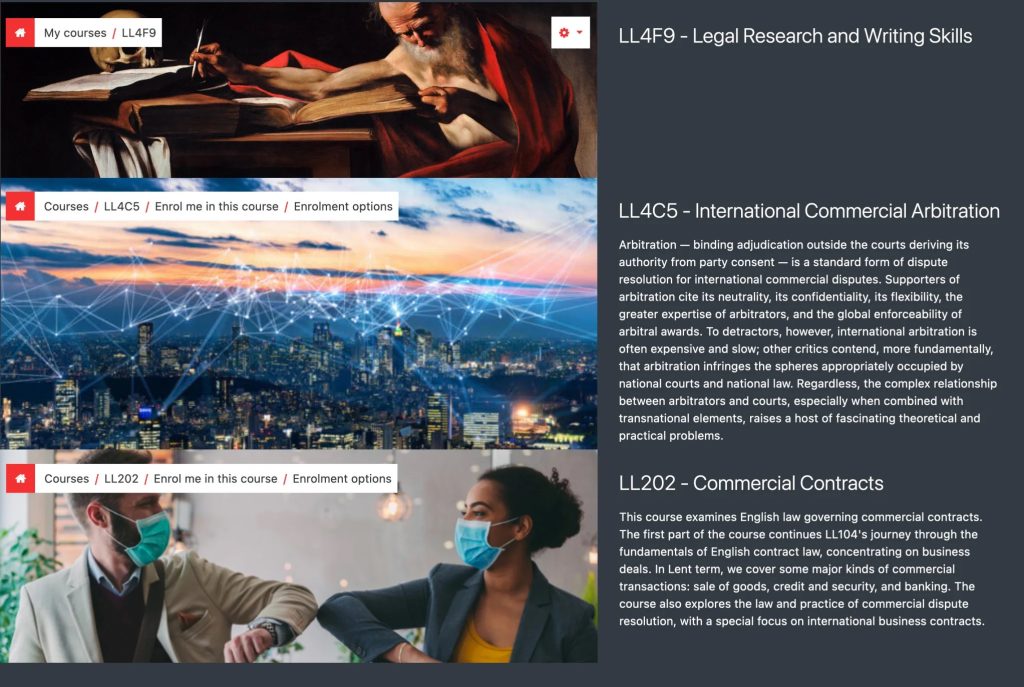Pedagogy has taken a pictorial turn but simply adding stock images to PowerPoint presentations adds little value to learning and can even be harmful, argues Mikolaj Szafranski
There is nothing new in saying that there is an imperative for teaching to appear attractive to students. Some treat this imperative as meaning that teaching materials must be visually attractive, or at least alternate between text-heavy content and some illustrations. When PowerPoints became ubiquitous, pedagogy took a pictorial turn. In this blog post, I explore the implications of this for the teaching of law, and I focus on uncovering the controversies surrounding one particular practice of pictorial pedagogy: the use of stock photography.
While it is hard to find quantitative or empirical studies analysing what kind of cognitive engagement can be generated in teaching with the use of images, most academic educators have probably internalised some rationales about the value of using images in teaching materials. Roberts points out that multimedia learning theory – a body of literature which seemingly helps to shape teachers’ visual engagement skills – “does not predict active learning processes; it is mainly concerned with efficiency and management”. The case for visual stimulants, as Roberts calls them, might not be scientifically sophisticated. Working on the assumption that students might not have the cognitive power to deal with slides that are filled with text, Roberts argues that “[u]sing images frees up processing power and evens the load”.

But can all images be entrusted with the same function of easing the cognitive load? Specifically, can images encourage students to think and reflect on the material if they are nothing but generic illustrations? I allude here to a tendency I have been observing since my first lectures as an undergraduate. Do you want to refer to tort law? A photo of a ginger beer bottle, alluding to the seminal Donoghue v Stevenson, is mandatory (bonus points if you find one from the time when the case was decided rather than a contemporary equivalent). Lecturing on law of the sea? Let’s begin with an image of a beach view. Got a question you want the audience to react to? An image of a student appearing to be engaged in reflection (ideally pencil-biting or holding their chin) will do. In the quest for designing attractive materials, image search engines become your closest allies, as do stock photo banks such as Shutterstock or Getty.
Stock images of this kind are as controversial in media as they are in teaching. Used in a law classroom, they can predetermine the perspective from which a problem is approached.
As a result, images in teaching become something akin to library music or muzak – necessary background without which we cannot imagine a hotel elevator ride. Yet this inclination to use imagery is not free from problems. One context in which the use of stock images might be objectionable are discussions of child sexual abuse. Nicola Döring, who analysed this tendency in media reporting, talks about a distinction between documentary and symbolic photos. The former depict the authentic facts of the case while the latter are “prefabricated photos taken in completely different contexts”. While stock photos belonging to the latter category have some benefits from the point of view of editorial convenience (“they are easily recognisable, attract attention, and can emotionalise the audience”), it is questionable whether survivors of child sexual abuse would see them as appropriate. Döring mentions two examples of the most common tropes in such photos. The first trope, dubbed “victim before or during a crime”, results in objectifying the victims and “[sexualising] them through light clothing and camera focus between the legs, and [forcing] the media audience into the role of perpetrator”. The second example is the trope of “consequences of the crime for the victims” – so photos that seek to visualise the suffering of the victim. Döring finds these as framing the victims as passive sexualised objects devoid of “any hope of overcoming the trauma of abuse and creating a positive future”. In summary, symbolic stock photos aspire to convey a message of relevant (if not veracious) representation of a victim’s experience. Yet they only provide the audience with a romanticised ersatz of the victim’s experience.
Stock images of this kind are as controversial in media as they are in teaching. Used in a law classroom, they can predetermine the perspective from which a problem is approached. This warrants a reorientation of the impulses that govern educators in selecting media for teaching materials. We may want to question why we need to rely on the medium of stock imagery itself when teaching controversial topics. Today, most educators are wary that graphic representations (whether pictorial or not) might warrant a contextual introduction or a trigger warning. But whereas a trigger warning “allows the student to mentally prepare, and to put tools in place to ameliorate strong reactions”, a benign stock image does not warrant the same reaction. In fact, because of its mildness, a stock photo may lull the student’s emotional engagement. By operating with a symbolic and unspecific representation, stock photos put minds and hearts at ease, and become the antithesis of a trigger warning.
My way of going about this vexation of pictorial engagement is to make room for cheeky humour.
Taking stock of the above, I made some radical decisions in my own approach to images in teaching. As someone who sees scientific inquiry as a quest for situated knowledge, I am prone to conclude à la Haraway that stock photos provide a view from nowhere. Not keen on spending hours in Google image searches, I have refrained from using generic images found online. I have not embraced ascesis, however. I limit my image use almost exclusively to photos that I have taken and manipulated myself (with legal memes being the main exception to the rule). To a large degree, I use images as caricatures. Knowing that students of the pictorial era might expect me to use photos, I decided to play with and against such an expectation. In short, my way of going about this vexation of pictorial engagement is to make room for cheeky humour.

Looking back, I exercised a judgment about what kind of pictorial engagement I want to see in my classroom. Biesta affirms that “[conscious] judgment is at the heart of education and mediates between three distinct purposes of education: qualification, socialisation, and subjectification”. Biesta’s tripartite classification of purposes of education is helpful here, as it conveys the point that not every type of knowledge and engagement is born equal. Rather than castigating some practices as categorically fit or unfit for our classes, we may want to specify, following Biesta, what this practice is useful for. Some law educators realise that very well in regards of images. Pahuja and Baskin make space for critical engagement with images in their law and development classes. The Less Textual Legal Gallery curated by Allbon offers a rich cross-section of resources created specifically for the purpose of furthering visual learning and communication in law. One does not need to revert back to the ‘ancient’ or pre-PowerPoint textual ascesis.
The use of images in teaching is a choice. As choice-makers, we make judgments that have implications for the students. Amid the pictorial turn, can we ever claim that we are using images as simply instruments for teaching? Or do we seek to develop visual literacy and reflection as a sui generis disciplinary skill?
Note: A version of this post first appeared on 17 April 2023 on the Contemporary Issues in Teaching and Learning Blog, part of the PGCertHE programme at the LSE.
_____________________________________________________________________________________________
This post is opinion-based and does not reflect the views of the London School of Economics and Political Science or any of its constituent departments and divisions.
_____________________________________________________________________________________________
Main image: JESHOOTS.COM on Unsplash



